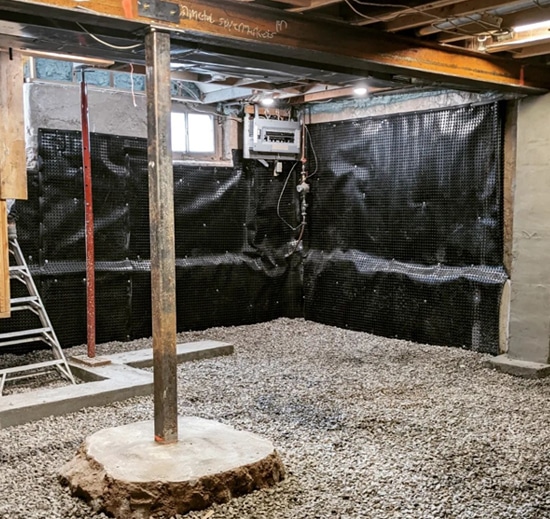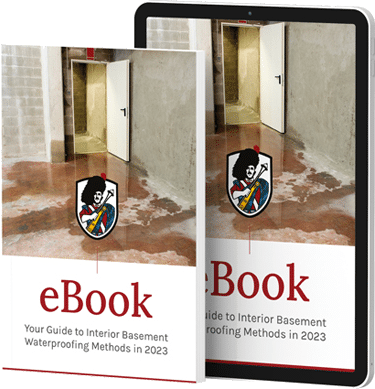Sump Pump Installation Toronto & GTA
Premier Sump Pump Installation Services: A Reliable Solution to your Basement Water Woes!
Our Services Are Trusted By








Sump Pump Toronto: Reliable Dry Basements
Sometimes, it isn’t easy to know what’s happening in your basement, but just imagine having to keep up with what’s happening beneath it. When rainwater is stored inside the soil around your foundation, it raises the water table, which can result in hydrostatic pressure. This hydrostatic pressure can cause cracks in your foundation and floor, letting water inside your basement. Building concrete below grade can be troublesome without a proper sump pump waterproofing strategy. During heavy rain, your home’s weeping tile system can become overwhelmed. It may not function properly as the amount of water can overload its flow, which results in water entering the basement. This issue can be solved by installing a sump pump to remove pressure from your water table.

What is a Sump Pump?
The sump pump is a device used to pump away water underneath your basement floor and away from your home’s foundation. A sump is a pit dug at the lowest point of your basement, also known as a sump basin. Water flows to the basin through weeping tile or naturally migrates through the soil and is collected in the sump pit. When a certain level of water is reached in the sump pit, the pump starts automatically and begins to pump away the water through a discharge pipe and away from your foundation. This way, your basement stays dry from below, and numerous water-related issues can be solved. If you want additional peace of mind, you need a backup sump pump to ensure your basement stays dry, no matter what. Call us today for expert sump pump installation experience in Toronto.
Why Install a Sump Pump?
Installing a sump pump is a wise investment to ensure your home stays protected and dry. Peace of mind comes with installing a reliable sump pump, assuring protection during wet seasons and extreme weather. If you live in a region where it rains the heaviest or has dense snowfall, sump pumps divert the excess water to prevent flooding and damage in your basement. They add property value, especially in flood-prone regions, boosting appeal to potential buyers and resale prices. By averting water accumulation, they maintain structural integrity, reducing foundation cracks and shifting. They also prevent water damage, lowering the chance of costly repairs and harm.
In addition, sump pumps create a drier environment, curbing mould and mildew growth and protecting property and people. They are customizable in types and sizes and can come with a battery backup for power outages. While there’s an upfront cost, sump pumps save long-term repair expenses and health risks.
In summary, installing a sump pump provides a comprehensive solution to mitigate water accumulation and its associated risks, offering protection and peace of mind for the long run.
6 Step Repair Process:
01
Determine Origin of Leak
Determine moisture or water entry location to help us determine the leak’s origin in your basement.
02
Sump Box Evaluation
A sump box is also referred to as a sump basin. Whether you require a new sump box installation or will be utilizing an existing sump basin, be sure the basin is the proper size and build.
03
Industrial Sump Pump
Once the sump basin is prepared, choose a robust industrial oil-cooled pump with an exterior float.
04
Yearly Maintenance
Over time, flowing water tends to bring small traces of sediment into sump basins. Inspect the basin yearly and remove any debris.
05
Cost Vs Workmanship
With dozens of contractors out there, be sure you are getting what you pay for. Beware of the recently saturated basement waterproofing marketplace.
06
Drainage
Maintain your eavestrough and downspouts year round; ensure your grade is positively pitched away from foundation walls.
Sump Pump Repair & Installation Experts in Toronto

GJ MacRae is a full-service basement waterproofing and foundation repair company in Toronto. We provide a wide range of services, including sump pump installation and repair services. We are family-owned and operated since 1975 and have carried out 10,000+ waterproofing projects. A basement can be completely dry and protected from basement flooding only if it is waterproofed with all elements considered. Areas with a high water table require additional sump pump waterproofing methods to keep the basement dry from water rising from the floor. A sump pump can be the ideal solution for such areas.
GJ MacRae Foundation Repair has provided sump pump installation services for the last five decades and delivers dry basements to customers. Installing a sump pump is not something you do every year, and you would want a sump pump installation in Toronto from experts like GJ MacRae. Power loss can sometimes happen, making it wise to have a battery backup sump pump to address such events. We take special consideration while selecting the suitable pump and basin size, considering the depth of your basement, the drainage area, and the distance the water needs to be pumped away from home. GJ MacRae knows the value of a dry basement and guarantees to deliver one. Feel free to contact us if you are looking for any basement waterproofing or foundation repair service.
Sump Pump Installation Process
When you hire us, we deliver quality results. During the basement sump pump installation process, our technicians will arrive at the site and inspect your basement situation. We will clean the area, choose the location suitable for installing the pump, and start excavation. A hole of appropriate size to the sump basin is dug, and gravel and filter cloth are installed into the excavation. The basin is then set inside the sump pit and surrounded with gravel. The weeping tile system is then connected to the sump basin to collect water.
The pump is now fitted inside the sump basin. Choosing the right pump depends upon various factors. We always recommend using an oil-cooled submersible pump. It is a little expensive but much more cost-effective in the long run. Then, an outlet pipe is connected from the pump to the outside of your basement walls, diverting water away from your foundations. The outlet pipe must have a one-way check valve to prevent the backflow of water to the basin. After all this is done, we pour water into the basin and check the pump. After everything is working correctly, the basin cover is put on, and the sump pump is installed.
Why Choose GJ MacRae?
- Highest Rated Customer Service: Customer satisfaction is our primary goal. We will work with you closely to understand your needs and provide the best solution to your foundation repair project.
- Comprehensive Services: With GJ MacRae, homeowners can find all foundation repair solutions under one roof. From foundation crack repair to exterior waterproofing and weeping tile installations, we have the expertise and resources to address your complete waterproofing needs from start to finish.
- Extensive Experience: With nearly 50 years of experience in the industry, GJ MacRae is known for delivering quality, long-term basement waterproofing solutions while tackling even the most challenging waterproofing projects with confidence and expertise.


Protect Your Foundation
- Competitive Pricing: GJ MacRae offers competitive basement waterproofing services without compromising quality. We provide transparent, fair quotes that ensure homeowners receive the best long-term value.
- Quality Materials: GJ MacRae uses high-quality repair materials combined with the latest waterproofing techniques, and we are experts in all phases of basement waterproofing. Plus, we offer innovative solutions that guarantee long-lasting protection against water infiltration.
- Protect Your Investment: When protecting your foundation walls and basement from water damage, choosing GJ MacRae Foundation Repair for basement waterproofing in Toronto ensures you receive the highest quality repair solution to safeguard your foundation long-term.
Basement Waterproofing and Foundation Repair Projects in Toronto and the GTA
A Word from Our Customers
Download Our Free eBook
We’re honored to provide these resources to help you on your journey, and we know reputations are hard to build and easy to lose. That’s why our business is built around two simple promises:
Honesty and Transparency.
We genuinely want each step of your journey (from the very first Google search to a leak-free basement) to be positive!

What Does quality Foundation Repair Look Like?
RECENT PROJECT PHOTOS
RECENT PROJECT VIDEOS
Sump Pump Installation For a Dry Basement
Sump pumps are a great way to keep your basement dry. An excellent drainage system, like a weeping tile system, when partnered with a sump pump, helps to keep your basement dry. Divert away all the water beneath your basement away from your foundation and save thousands of dollars in sump pump repairs.
Need a sump pump installed or repaired? Contact GJ MacRae, the finest sump pump installation contractor in Toronto. Give us a call or fill out the form below, and our team will inspect your basement and provide you with an ideal solution for a sump pump installation. Feel free to contact us at (905) 824-2557 or complete the form below.

Our Service Areas
At GJ MacRae, we take pride in extending our services across the GTA to meet our valued customers’ unique needs, and our dedicated team is committed to delivering top-notch solutions all year long. Our expansive service areas are a testament to our unwavering commitment to the highest quality foundation repair services and customer satisfaction in the GTA.
Schedule a Free Consultation Today
Fill out our request form and we will contact you as soon as possible for a free foundation repair consultation!
Frequently Asked Questions
Steps to replace a sump pump:-
- Disconnect the old pump
- Remove it from the pit
- Install the new sump pump
- Install proper check valve
- Reconnect to existing plumbing connection
The average cost of a complete sump pump installation in Toronto can differ based on factors like the type of pump, depth of basin, and overall access.
A high-quality sump pump manufacturer that we recommend is Liberty Pumps.
The time it takes to install a new sump pump and basin in Toronto can differ based on basin depth, access, and pump specifications. Installation. Call us today for more information.
A sump pump manufacturer warranty is generally for ten years.
These steps will help you find a reliable contractor for sump pump installation in Toronto:
- Advice from friends, family, and online reviews.
- Verify credentials, licenses, insurance, and memberships.
- Look for experienced contractors with a proven track record.
- Request and contact references from past clients.
- Conduct in-person consultations to discuss the project.
- Ensure all project details are documented in a written contract.
- Trust your instincts and choose a contractor you’re comfortable with.
- Utilize online platforms and directories to research and compare.
- Prioritize good communication and responsiveness.
Expert Waterproofing Services for Your Home
GJ MacRae Foundation Repair has been the industry leader for reliable basement waterproofing in the Greater Toronto Area Since 1975. Nearly five decades of experience inform our proven multi-stage repair process based on below-grade drainage considerations that allow us to waterproof concrete blocks, poured walls, and stone rubble foundation walls properly for the long term. Our repair solutions for leaking foundation cracks include using bitumen-based barrier membranes and high-efficiency weeping tile systems, which give us the edge in reliability and allow for the most robust foundation repair warranty available today in the GTA. Experience the GJ MacRae difference for year-round basement leak repairs in Toronto, Oakville, Mississauga, Burlington, Hamilton, Milton, and Georgetown. If you spot cracked foundation walls, leaky foundations, or any other basement waterproofing issues in your house, reach out and call us today at (905) 824-2557.







